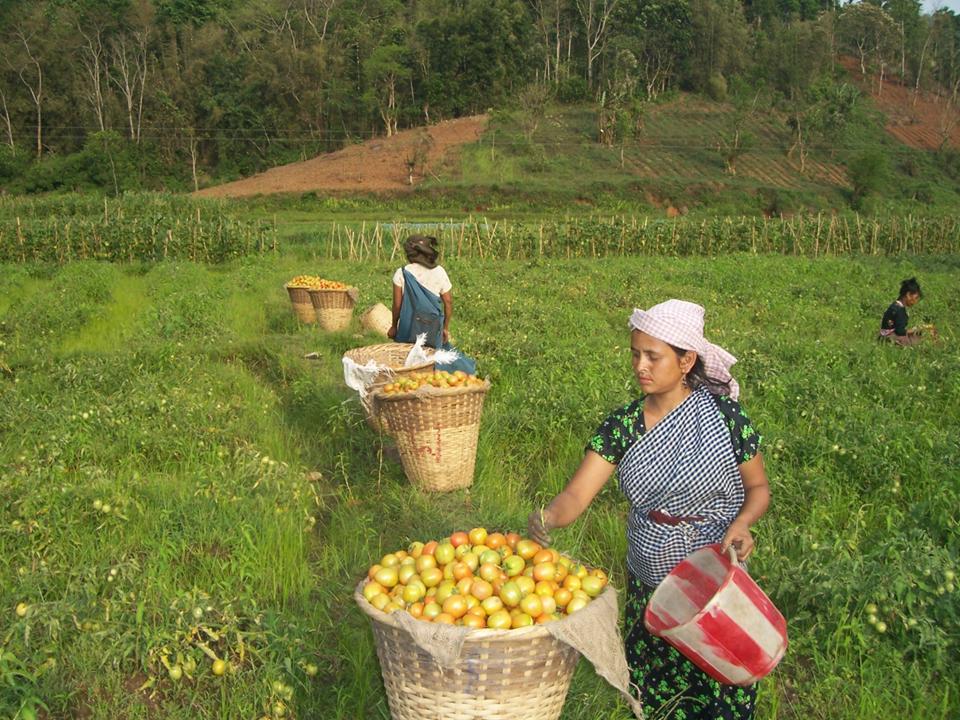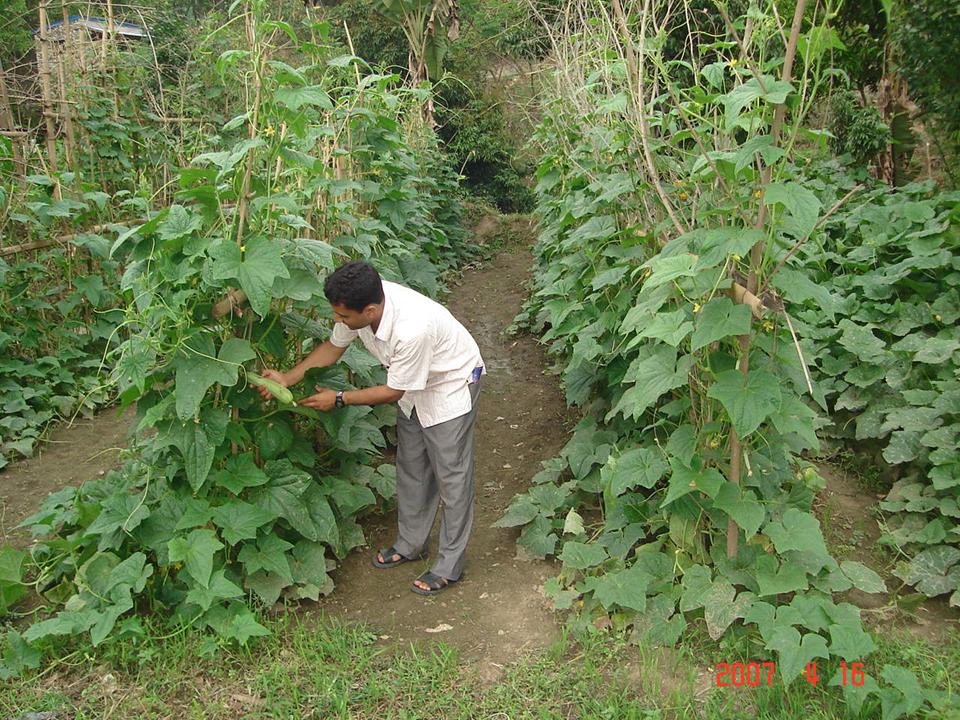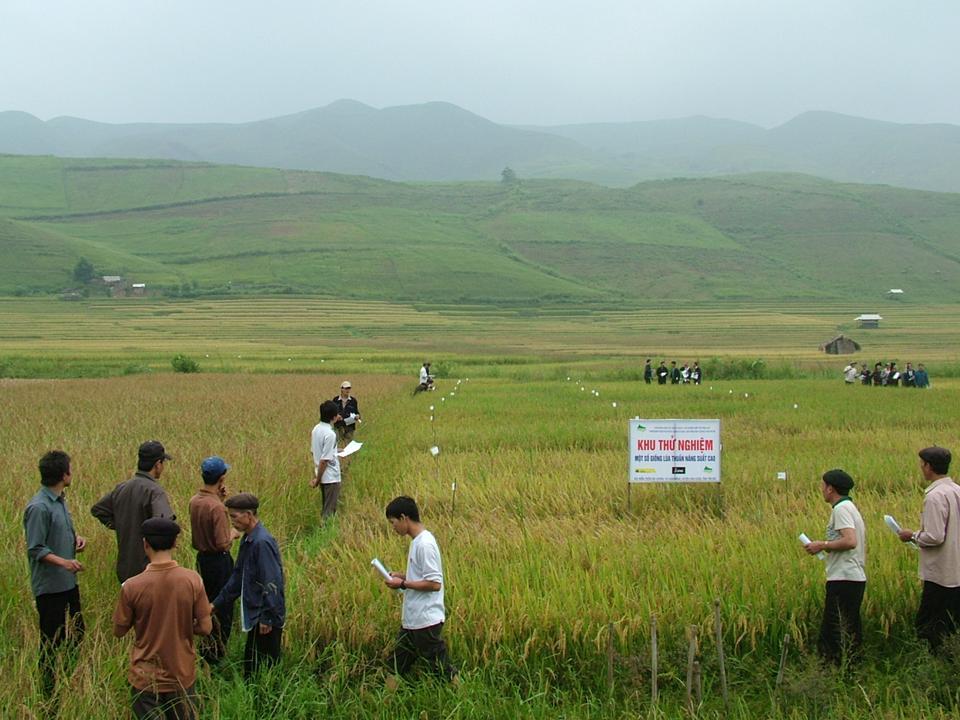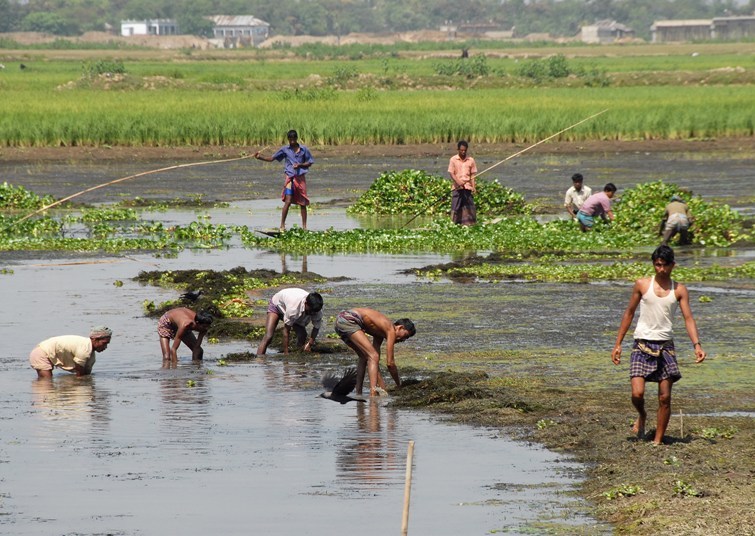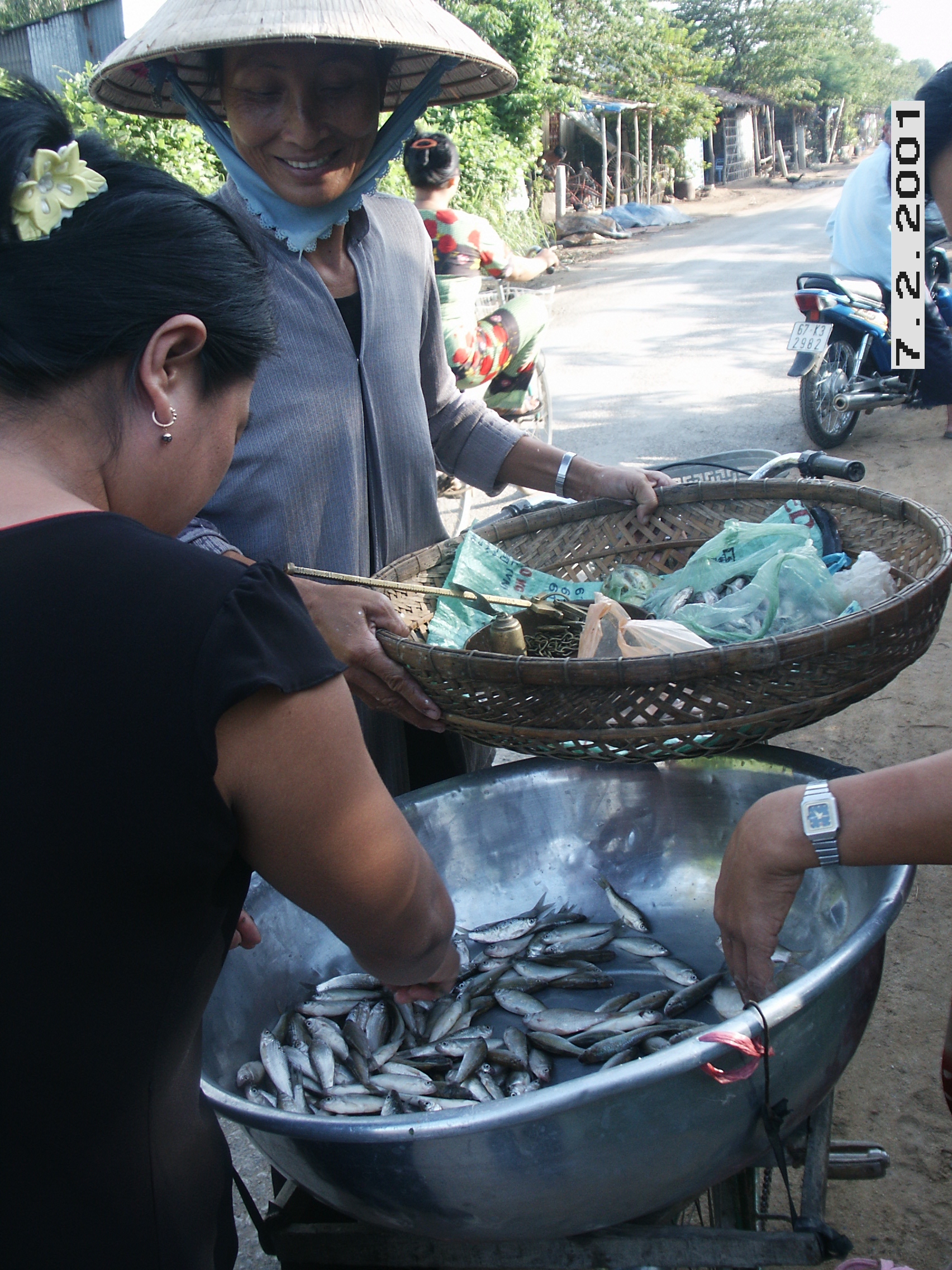
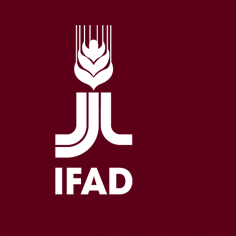
|
Supporting agricultural research through grants
Message from the Grants Coordinator IFAD is supporting a number of regional grant programmes in the Asia and the Pacific region that aim to:
Support to agricultural research and technology is an important component of IFAD’s grant programme. It can provide poor rural people living in remote and marginal areas with the knowledge and innovations they need to increase the productivity and sustainability of their production systems. IFAD provides grants to institutions to support pro-poor agricultural research activities. Often, these institutions fall under the Consultative Group on International Agricultural Research (CGIAR), a strategic partnership including 15 international centres generating cutting-edge science to foster sustainable agricultural growth. Such growth benefits poor people through stronger food security, improved human nutrition and health, higher incomes and improved management of natural resources. Pro-poor sustainable agricultural research strengthens the technical and institutional capacities of national research systems linked to agricultural and rural development. It also promotes farmers’ participation and adopts multidisciplinary approaches to technology generation, validation and dissemination. This year, two issues of the newsletter will be entirely dedicated to describing a selection of regional grant programmes, some of which are still in progress. This issue provides an overview of the agricultural research carried out by CGIAR centres in IFAD-funded grant projects in different sub-regions of Asia. It also presents the results that can potentially alleviate poverty, sustain a healthy environment and provide alternative livelihoods to poor rural people. Another issue of the newsletter on grants will be published in December 2008. Carla De Gregorio, Grants Coordinator, Asia and the Pacific Division Back to topNew groundnut variety brings hope to poor farmers in India
A new variety of groundnut (ICGV 91114 or ‘Anantha Jyoti’) has generated hope among poor, rain-dependent groundnut farmers in the district of Anantapur in Andhra Pradesh. Among its many benefits, it produces higher yields of fodder and tolerates droughts. The variety was introduced by the International Crops Research Institute for the Semi-Arid Tropics (ICRISAT) through the ‘farmer participatory on-farm varietal selection approach’. IFAD supported ICRISAT through a US $1.3 million grant entitled Programme for Farmer-Participatory Improvement of Grain Legumes in Rainfed Asia (2002-2007). Anantapur is the largest groundnut-growing district in southern India. About 1 million hectares of land are devoted to growing groundnut. The area is characterized by erratic and uneven rainfall, frequent droughts, gravely fields with poor and shallow soils, and resource-poor farmers. In these conditions, crops fail in three out of five years. The average yield of groundnut in the rainy season in the district is only 400 kg per hectare. Groundnut can survive dry spells better than other crops. During crop failure, groundnut can at least provide some fodder for farmers’ livestock. For these reasons, the cultivation of groundnut is expanding. Until the 1960s, groundnut covered only 20 per cent of the district’s arable area. Currently, it covers more than 70 per cent. Nevertheless, farmers are using a very old groundnut variety – TMV 2, released in 1940. It is low-yielding and susceptible to diseases and pests. The Programme for Farmer-Participatory Improvement of Grain Legumes in Rainfed Asiahas played a crucial role in providing farmers with new varieties of groundnut. The varieties respond to farmers’ preferences, which are based on their perceptions of what they consider most important. For example, in Anantapur farmers highly value drought tolerance and fodder quantity and quality. The programme worked with organizations such as the Rural Development Trust, Agricultural Research Station, Acharya NG Ranga Agricultural University, and farmers to find a replacement for TMV 2. It conducted trials with nine improved groundnut varieties. A participatory evaluation conducted by the programme showed that among the nine varieties tested, farmers preferred ICGV 91114 because of the following characteristics:
Farmers have benefited from cultivating ICGV 91114. Their additional income from producing and selling this improved variety ranged from INR 3,500 (US$ 83) to INR 4,375 (US$ 104) per hectare in 2007/08. In 2006 the Andhra Pradesh State Seed Sub-Committee approved the release of ICGV 91114 for general cultivation in the district. Mrs Shyamalamma, a farmer from West Narsapuram village, multiplied the seed of the improved variety on 0.63 hectares of irrigated land during the 2003-2004 post-rainy season. She produced 1,200 kg pods (1,920 kg per hectare) and sold her seeds to other farmers who planned to plant them during the rainy season in 2004. During the post-rainy season in 2007/08 farmers produced 9.6 tons of seed of ICGV 91114 from 46 hectares of land. This year during the rainy season, they plan to produce seed of this variety on 480 hectares of land. The gains made through the programme are being consolidated and scaled up at both original and new locations under another IFAD-supported grant programme, the Programme for Harnessing the True Potential of Legumes: Economic and Knowledge Empowerment of Poor Farmers in Rainfed Areas in Asia (2007-2012). The US$ 1.4 million programme supports poor farmers in India, Nepal and Viet Nam. In India, the programme is promoting the local production of improved seeds to ensure that they are available for farmers in areas covered by two IFAD-funded projects in three states –the Jharkhand-Chattisgarh Tribal Development Programme and the Orissa Tribal Empowerment and Livelihoods Programme. Based on the collaboration with the Orissa University of Agriculture and Technology in Bhubaneswar, in 2008 the Orissa State Seed Sub-Committee released ICGV 91114 (marketed as ‘Devi’) for cultivation in the state. ICGV 91114 has shown a pod yield superiority ranging from 3 to 42 per cent over traditional varieties, and is especially popular among tribal farmers. The farmer-participatory approach in agricultural research and development is providing a powerful tool for personnel involved in research and development, particularly in rainfed agriculture. Through this approach, solutions are being found to constraints that have been persistent. S. N. Nigam, Principal Scientist (Groundnut), ICRISAT Read more about:
Back to topIFAD funds research on three bioenergy crops
High prices of fuel and food may become a routine phenomenon for the years to come. Prices of crude oil have increased more than 400 per cent since 2004, creating a global imbalance between demand and supply. Developing counties will have to find effective ways to provide a cushion to poor rural people to prevent them from becoming poorer, especially since the high prices of oil are also pushing up prices of fertilizer. With financial assistance from IFAD, the International Crops Research Institute for the Semi-Arid Tropics (ICRISAT) is carrying out research on sweet sorghum for use in ethanol production and jatropha for use in biodiesel production. Its ‘sister’ – the International Center for Tropical Agriculture (CIAT) – is conducting research on cassava, which can be used as raw material or feedstock in ethanol production. ICRISAT’s BioPower strategy focuses on sources of feedstock and approaches that produce both food and fuel. The US$ 1.5 million IFAD-funded grant project ‘Harnessing water-use efficient bioenergy crops for enhancing livelihood opportunities of smallholder farmers in Asia, Africa and Latin America’ was launched in May 2008. Through research, the project aims to promote the cultivation of sweet sorghum (in India, Mali and the Philippines), cassava (in China, Colombia and Viet Nam) and jatropha (in India and Mali). The goal of the project is to improve the livelihoods of smallholder farmers and landless rural families by enabling them to use improved technology for cultivating bio-energy crops. It will also help to build effective supply chain linkages through an innovative coalition of partners comprised of farmers, researchers, non-governmental organizations (NGOs) and representatives of the bio-fuel industry. These linkages should enable the cost-effective and sustainable production of bio-fuels in Asia, Africa and South America. The project is focusing on four main activities:
Dr William D. Dar, Director General of ICRISAT, considers sweet sorghum as an ideal 'smart crop' because it produces food, fodder and fuel, and can improve the income of farmers in the semi-arid tropics by at least 20 per cent. Other crops such as jatropha, which can be grown on degraded lands, help farmers earn additional income. Cassava, a drought tolerant crop, grows well in rainfed soils in Asia and Latin America. CIAT is taking the lead role to improve cassava for ethanol production. Studies conducted at ICRISAT in Patancheru, India showed that the reduction in grain yield with sweet sorghum is negligible compared to grain sorghum. These results should alleviate the concerns about the trade-offs between food and fuel, as the raw material for ethanol production are the stalks and not the grain. For all three crops, effective production-supply chain linkages can substantially increase the incomes of small and marginal farmers when they sell raw material (either sugar-rich stalks / starch-rich cassava) to bio-ethanol distilleries or oil-containing jatropha fruits to bio-diesel production firms. For example, with sweet sorghum, the sugary stalks are used for ethanol production. They are sold for Rs 650 (US$ 16) per ton to the distillery. The project outcomes can provide a win-win situation for developing countries, since there is no food-fuel trade-off and farmers can obtain remunerative prices for the sweet sorghum stalks and cassava starch/flour. Countries are thus able to save money they now spend on oil imports and invest it in bioenergy crops such as sweet sorghum and cassava for ethanol production and jatropha for biodiesel production in dry areas. Dr P.Srinivasa Rao, Scientist - Sorghum Breeding, ICRISAT Read more about: Back to topManaging rice landscapes in marginal upland areas to increase food security and sustain the environment
More than 40 million people living in the uplands of South and South-East Asia depend on marginal lands to grow rice for their survival. They are caught in a vicious circle of low productivity, food and resource insecurity and environmental degradation that perpetuates poverty. The IFAD-supported programme ‘Managing rice landscapes in the marginal uplands for household food security and environmental sustainability’ is led by the International Rice Research Institute (IRRI) and is being implemented in India, Lao People’s Democratic Republic (PDR), Nepal and Viet Nam. The programme aims to enhance the productivity of rice cultivation and conserve natural resources. The four-year programme began in 2005 and is being supported by an IFAD grant of US$ 1.19 million. It emphasizes the participation of farmers in the research being conducted on potential technologies. The programme operates through a network of 14 village-based field research sites in the four countries to validate and generate appropriate technologies. In this research, IRRI collaborates with the following national agricultural research organizations:
To date, the programme has identified the following technologies: India
Lao PDR
Nepal
Viet Nam
IRRI is disseminating these technologies in collaboration with provincial and district extension organizations and IFAD-supported projects in the four countries. In 2006 and 2007, the programme distributed some 20 tons of high-yielding improved rice variety seeds to farmers. Sushil Pandey, Project Leader and Senior Scientist Read more about:
Back to topPoor fishers in Bangladesh and Viet Nam reap the benefits of improved community-managed floodplains
Supported by a technical assistance grant from IFAD, the WorldFish Center and its local partners initiated the project Community-based Fisheries Management Programme in South and Southeast Asia (2001-2008).Through this US$ 650,000 project, the WorldFish Center successfully developed new management approaches in Bangladesh and Viet Nam that provide local fishers with ownership of natural resources. The ownership of these resources enhances biodiversity and productivity, and increases fishers’ income. Addressing the concerns To address these concerns, the Community-based Fisheries Management (CBFM) Programme in South and Southeast Asia financed by IFAD was implemented in the two countries by the WorldFish Center. Its main partners were:
The project aimed to improve inland fisheries management policies of the two governments and NGOs. Improved policies would result in more sustainable, equitable and participatory management of resources, which would enhance the livelihoods of fishers in the deeply flooded areas. To accomplish this, the project improved existing fisheries management approaches and developed new ones that were suited to different communities and their ecological and political settings.
Effective community-based fisheries management In Bangladesh, the project formed community-based organizations (CBOs) comprised of mainly poor fishers to manage each of the six open floodplains in Sunamganj district. It also formed one management committee in Viet Nam (Vietnamese equivalent to a CBO). The community groups involved 503 direct beneficiaries in Bangladesh and 100 in Viet Nam. Guided by the WorldFish Center, the partner NGOs developed three main pillars for success:
Reaping the benefits The project’s key successes include:
Similarly, in Viet Nam, the project had a great impact on fish production and income of the participating households. The average fish catch per household increased fourfold compared to the period before the project started. Some key differences arose between the two countries:
Scaling up As a result of this success, the local provincial government in Viet Nam plans to expand the implementation of the CBFM model. In Bangladesh, the CBFM approach has been included in the government’s new Inland Capture Fisheries Strategy, the fisheries component of its Poverty Reduction Strategy Paper, and at least two other major on-going projects such as the IFAD-funded Sunamganj Community-Based Resources Management Project and the Integrated Protected Area Co-Management Project funded by the United States Agency for International Development. Read more about:
Back to topImproved production, processing and use of root crops intensify livestock production and improve food security in Lao PDR
For the past five years, IFAD has been supporting the Programme for Integrated Upland Agriculture Development Using Participatory Approaches in China, Laos and Vietnam (PRDU) through a US$ 1.45 million grant to the International Center for Tropical Agriculture (CIAT) and the International Potato Center (CIP). The programme is providing technical and methodological support to five IFAD-funded investment projects in China, Lao PDR, and Viet Nam and their implementing partners in the local extension services. It engages smallholder farmers, mostly from ethnic minorities, in participatory technology development that seeks to improve food security and increase income. In Lao PDR, CIAT and CIP worked with their partners and farmers to implement on-farm trials of improved varieties of sweet potato and cassava. In the remote mountainous areas of Oudomxay province in northern Lao PDR, farmers from the Khamu ethnic minority group used to grow cassava and sweet potatoes only as minor food crops within their traditional upland rice-based shifting cultivation. In addition to poultry and a few free-ranging ruminants, each household kept a few pigs that survived on household wastes and greens collected from the forest. In such low-input production systems, pigs took two to three years to reach marketable weight, and production for sale was not a viable livelihood strategy.
CIAT and CIP responded to the interest of the villagers in generating income by intensifying livestock production. Their scientists and partners from collaborating research institutions in Lao PDR and Viet Nam worked with the IFAD-supported Oudomxay Community Initiatives Support Project, its implementing partners in the extension services and villagers to implement on-farm trials of improved varieties of sweet potato and cassava. These root crops can improve food security and human nutrition, and also increase the nutritional value and improve the seasonal supply of rations fed to pigs. PRDU organized training on crop management technologies, such as multiplication, intercropping and soil erosion control, and integrated pest management. After harvest, researchers and extensionists held training on root crop processing and feed conservation (chopping, drying, silage-making), and ration formulation. The demonstration trials of pig feeding managed by farmers showed that:
Villagers appreciated the improved availability and higher-quality varieties of sweet potatoes. A sweet potato specialist from the Vietnamese Food Crops Research Institute worked with local nutritionists and representatives from the Lao Women’s Union to organize training that demonstrated alternative ways of preparing food and encouraged the use of high beta-carotene varieties to supplement the diets of women and children, who are generally deficient in vitamin A. PRDU has demonstrated that combining improved technologies with participatory methodologies is an effective way to improve the livelihoods of marginalized and poor rural people. Keith Fahrney, Project Coordinator, PRDU Read more about:
Back to topEstimating the cost of providing environmental services through conservation auctions
The IFAD grant-funded ‘Programme for developing mechanisms to reward the upland poor of Asia for environmental services they provide’ (RUPES) piloted a conservation auction in Sumberjaya Sub-district in Sumatra, Indonesia. The aim was to estimate the cost to farmers of investing in reducing erosion – in this case, reducing sedimentation. When farmers provide environmental services, they incur costs that are difficult to estimate, since there is a lack of information on minimum payments farmers accept for providing these services. This information is private and varies from farmer to farmer. The team from the World Agroforestry Centre tested the ‘auction approach’ to understand the cost to farmers of supplying environmental services – in this case, reducing sedimentation – and to then efficiently allocate the conservations contracts among them. A conservation auction is a procurement auction where farmers as sellers offer their availability to reduce sedimentation through a monetary bid. The World Agroforestry Centre represented the local hydropower company as a potential buyer. Holding conservation auctions in the rural areas of developing countries can be challenging, especially if literacy levels among some farmers are low or non-existent: the auction process requires that farmers submit written sealed bids, in order to prevent powerful actors from influencing the amount they decide to offer if the participants bid openly against one another. Ensuring that farmers understood the auction mechanism was an important part of the design and implementation of the auction. They were told to bid based on how much they would need to be paid to implement the sedimentation reduction service. The farmers compete to provide the service by offering progressively lower quotes. The bids were ranked by price per hectare until the budget from the buyer was exhausted. The RUPES team implemented three stages of auctions:
An evaluation at the end of the auction showed that farmers understood the auction process satisfactorily, as well as the nature of competitiveness and budget limitations during the auction. Bidding behaviour during the different rounds indicated that farmers adjusted their bids in response to previous outcomes, signifying their understanding. The farmers also considered the auction mechanism to be fair; the auction results did not cause any conflicts. Scientists from the World Agroforestry Centre and their partners are improving the design of the auction so that it is applicable to other environmental services such as carbon sequestration and biodiversity conservation. This will enable them to scale up the technique in other programmes, including RUPES II, approved by IFAD in April 2008. Finally, we acknowledge the Environmental and Economy Programme for Southeast Asia, administered by the International Development Research Centre of Canada, for its support in testing the initial design of conservation auction. Beria Leimona, RUPES Project Coordinator, World Agroforestry Centre Read more about:
Back to top |
||||||||||||||||||||||||||||||||||||||||||||||||||||||||||||||||||||||||
|
||||||||||||||||||||||||||||||||||||||||||||||||||||||||||||||||||||||||
![]()
|
|
[email protected] Martina Spisiakova
Making a Difference in Asia and the Pacific Issue 22: August 2008 Issue 21: June-July 2008 Issue 20: January-February 2008 Issue 19: January-February 2008 Issue 18: December 2007 Issue 17: September-October 2007 Issue 16: June-July 2007 Issue 15: Issue 14: January/February 2007 - Sustainable natural resource management Issue 13: November/December 2006 - PBAS: looking beyond the resource allocation system Issue 12: September/October 2006 - Communication for poverty reduction and rural development Issue 11: July/August 2006 - Working with UN agencies at the country level Issue 10: May/June 2006 - Indigenous peoples and ethnic minorities Issue 9: March/April 2006 - Access to land Issue 8: January/February 2006 - Agricultural Technology Management Issue 7: November/December 2005 - Pro-poor policies Issue 6: September/October 2005 - Gender & MDGs Issue 5: July/August 2005 - Partnership Issue 4: May/June 2005 - Rural Finance Issue 3: March/ April 2005 - Donor Harmonization Issue 2: January/ February 2005 Issue 1: November/ December 2004
IFAD The IFAD Executive Board approved the following projects/programmes during its 94th Session on 10-11 September: Indonesia – IFAD Support to the National Programme for Community Empowerment in Rural Areas Kyrgyzstan – Agricultural Investments and Services Project Afghanistan Design completion and quality assurance mission – Rural Microfinance Project, 1-14 November 2008 Bangladesh Annual review of COSOP, Dhaka, end of September Supervision mission – Finance for Enterprise Development and Employment Creation Project, 20-30 November 2008 Bhutan Mid-term review mission – Agriculture Marketing and Enterprise Development Programme, October 2008 Cambodia Fact-finding mission – new project, August–October 2008 Detailed project design and quality enhancement mission – new project, November–December 2008 Supervision mission – Rural Poverty Reduction Project in Prey Veng and Svay Rieng, October–November 2008 China Supervision mission – South Gansu Poverty-Reduction Programme, 19-30 October 2008 Supervision mission – Xinjiang Uygur Autonomous Region Modular Rural Development Programme, 19 October – 2 November 2008 Country programme review workshop – 13-14 October 2008 Start-up workshop – Inner Mongolia Autonomous Region Rural Advancement Programme, 17 October 2008 Follow-up mission – Environment Conservation and Poverty-Reduction Programme in Ningxia and Shanxi, 16-30 November 2008 Follow-up mission – Rural Finance Sector Programme, 20-30 November 2008 Mid-term review – Environment Conservation and Poverty-Reduction Programme in Ningxia and Shanxi, 17-30 November 2008 India Mid-term review mission – Livelihoods Improvement Project in the Himalayas (Uttaranchal and Meghalaya), 15 September – 15 October 2008 Joint review mission – National Microfinance Support Programme, 15-30 October 2008 Start-up workshop – Post-Tsunami Sustainable Livelihoods Programme for the Coastal Communities of Tamil Nadu, October 2008 Joint review mission – Tejaswini Rural Women’s Empowerment Programme in Madhya Pradesh, October 2008 Joint review mission – Orissa Tribal Empowerment and Livelihoods Programme, November 2008 Training of all project staff in financial management and procurement, Goa, end of November 2008 Training of all project staff in monitoring and evaluation (M&E), Results and Impact Monitoring System (RIMS) and results-based annual work plan and budget (AWP&B), Nagpur, 8-12 December 2008 Indonesia Supervision mission – Post-Crisis Programme for Participatory Integrated Development in Rainfed Areas, November–December 2008 Start-up support mission – National Programme for Community Empowerment, August–December 2008 Start-up workshop – Rural Empowerment and Agricultural Development Programme in Central Sulawesi, November–December 2008 Start-up workshop – National Programme for Community Empowerment, November–December 2008 Maldives Supervision mission – Post-Tsunami Agricultural and Fisheries Rehabilitation Programme, October–November 2008 Mongolia Supervision mission – Rural Poverty-Reduction Programme, 14-30 September 2008 Nepal Supervision mission – Western Uplands Poverty Alleviation Project, October–November 2008 Pacific Roundtable meeting on lessons learned from the Mainstreaming Rural Development Innovations Programme in the Pacific (MORDI), 29-30 September 2008 Biofuels conference on implications and opportunities for sustainable livelihoods organized by IFAD, the Secretariat of the Pacific Community (SPC), the Pacific Islands Applied Geoscience Commission, ,Nadi, Fiji, 3-5 November 2008 Pakistan Project completion review mission – Dir Area Support Project, October 2008 Workshop – Results-based COSOP, second half of November 2008 Six-monthly portfolio review meeting, second half of November 2008 Supervision mission – Microfinance Innovation and Outreach Programme, November 2008 Supervision mission – Programme for Increasing Sustainability and Outreach in Microfinance, November 2008 Supervision mission – Southern Federally Administered Tribal Areas Development Project, November 2008 Follow-up mission – Programme for Increasing Sustainability and Outreach in Microfinance, December 2008 Philippines Loan negotiations – Rapid Food Production Enhancement Programme Beginning, December 2008 Tajikistan Loan negotiations – Khatton Livelihoods Support Project, Dushanbe, 27-30 October 2008 Useful links Knowledge Networking for Rural Development in Asia/Pacific Region (ENRAP) is a programme financed and implemented by IFAD and the International Development Research Centre (IDRC). The programme aims to bring the benefits of accessing and sharing global information resources to IFAD-supported programmes and projects in the Asia and the Pacific region. Occasional papers are a series of studies on emerging thematic issues in the Asia and the Pacific Region published by IFAD. The papers contribute to IFAD’s efforts to share the knowledge and experience emerging from its activities and those of its partners in the region. Rural poverty portal powered by IFAD is a website where rural poor people, policy-makers, donors, research institutes, non-governmental organizations and other development partners can share information about eradicating rural poverty. |
![]()
The International Fund for Agricultural Development (IFAD) is a specialized agency of the United Nations, dedicated to eradicating poverty and hunger in developing countries. Its work in remote rural areas of the world helps countries achieve the Millennium Development Goals. Through low-interest loans and grants, IFAD develops and finances projects that enable rural poor people to overcome poverty themselves.
IFAD tackles poverty not just as a lender, but as an advocate for the small farmers, herders, fisherfolk, landless workers, artisans and indigenous peoples who live in rural areas and represent 75 per cent of the world's 1.2 billion extremely poor people. IFAD works with governments, donors, non-governmental organizations, local communities and many other partners to fight the underlying causes of rural poverty. It acts as a catalyst, bringing together partners, resources, knowledge and policies that create the conditions in which rural poor people can increase agricultural productivity, as well as seek out other options for earning income.
IFAD-supported rural development programmes and projects increase rural poor people's access to financial services, markets, technology, land and other natural resources.




